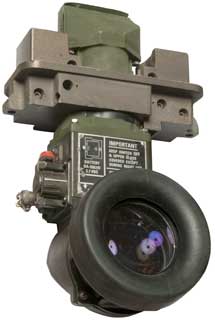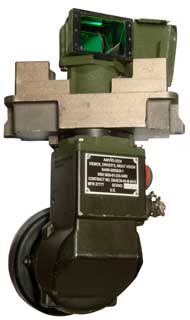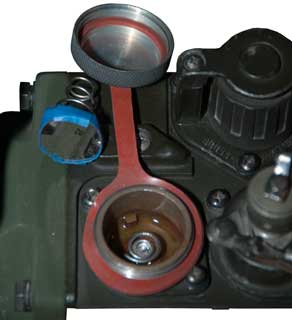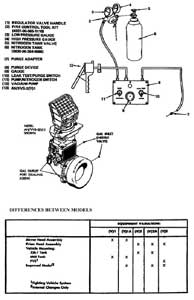VVS-2(V)4 Driver's Night Vision Viewer
© Brooke Clarke 2020
 |
 |
**************************************
Description
General
Variations
NSNs
Battery
External DC Power
Image Tube
Photos
Patents
Related
References
Links
Background
As part of my interest in Optics and military stuff.
From Forecast International Archive March 2001:
Total Produced. According to the manufacturer, through 1998, over 75,000 viewers had been produced. Application.
"The VVS-2(V) is a night viewing device designed for armored-vehicle drivers. Typical platform configurations include the M1A2 Abrams, V-150, LAV25 Piranha, M113, M60A3, M48, Armored Infantry Fighting Vehicle, M109 Howitzer, T54, PT76, and Fox NBCRS.
Price Range. The unit price is estimated to be between US$6,000 and US$10,000.
Technical Data
Characteristics
Field of View: 45° horizontal x 35° vertical
Total Field Coverage: 135° horizontal x 35° vertical
Depth of Focus: 4 meters to infinity
System Resolution: 1.25 milliradians
Linear Distortion: Less than 9% over entire image
Image Intensifier: 25 mm, Generation II
Power Supply: 28 V DC from vehicle, or internal lithium battery
Design Features.
The VVS-2(V) night viewing system is a second-generation, passive (non-visible-light-emitting) light amplification device. The VVS-2(V) allows a vehicle to be driven under night conditions without illumination. The area viewed is presented in varying shades of green, from near white to near black, with lighter reflections making up the brighter relief.
The system includes an objective lens assembly, an entrance window housing assembly, a main housing assembly composed of an electronic power control and electric power adapter, a low-level image intensifier, a 4-inch cathode ray tube (CRT), an eyepiece assembly, and a mounting device. The unit is light enough to be installed from within the vehicle, and can be manually rotated in azimuth from between 30° to 45°, depending on the vehicle’s configuration. The VVS-2(V) is a direct replacement of the US Army M19 and M24 active IR viewing devices.
Operational Characteristics.
The system amplifies all available ambient light by as much as 50,000 times. The picture is relayed through circuitry to a CRT tube/ screen, providing the viewer (the driver in this case) with a detailed, light-intensified image. An eyepiece is available as an alternative viewing option. Generation II image intensifier tubes feature automatic gain control and bright source protection. An ambient light detector acts as a protective circuit to cut electrical power to the image tube if the system is inadvertently turned on in daylight.
Variants/Upgrades
VVS-2(V)1/1A. Designed for the M60A3 main battle tank (MBT).
VVS-2(V)2/2A. Designed for the M1 and M1A1 MBT.
VVS-2(V)3. Designed for the M2 and M3 Bradley series armored vehicles.
VVS-2(V)4. The most recently reported variant in production. Intended for the M109 Palladin and the M992.
NDS-2. Export variant.
VVS-501. Export variant designed for Canadian Army’s Leopard 1 MBT.
Generation III retrofit. An upgrade that, according to Litton, provides 70 percent improved resolution over Generation II performance specifications. It is also offered by ITT Night Vision.
Korean production. Optechs Korea Inc manufactures several types of VVS-2(V) viewers, each of which applies to specific vehicles including the following: the VVS-2(V)M1924, the VVS-2(V)1A, the VVS-2(V)2A, the VVS-2(V)III, and the VVS-2(V)IV.
Timetable
Year Major Development
1971 US Army awarded Baird VVS-2 engineering development contract
1975 First production contract for 1,257 units
1978 First armor unit equipped
1985 Five-year OMNIBUS I contract awarded to ITT/Varo for 11,418 units
1987 M60 production ended following the completion of an Egyptian M60A3 order
1990 Three-year OMNIBUS II contract awarded to IMO/Varo
1991 VVS-2 production for OMNIBUS I completed
1994 OMNIBUS II production completed
1996 Varo Optical Systems became Litton Electro-Optical Systems
Description
General
TM 11-5855-249-10 shows the body mounted at an agle so that the face of the eyepiece rubber bumper is in a vertical plane. But this unit has square mounting surfaces so maybe the mounting hardware has an angled mating surface? Note Fig 6 below shows the eyepiece rubber bumper angled.
Variations
Variation
Head
Mounting Plate
NSN
NSN
Year
Drawing
VVS-2(V)1
Narrow
Mirror
Narrow
5855-00-629-5278
1975
SM-D-771324-1 VVS-2(V)1A "
"
5855-01-096-0871
1980
SM-D-771480-1 VVS-2(V)2 Narrow
Prism
Wide
5855-01-057-1880
1978
SM-D-771324-3 VVS-2(V)2A "
"
5855-01-096-0872
1980
SM-D-771480-2 VVS-2(V)3 Wide
Prism
Wide
5855-01-105-7793
1981
SM-D-771480-3 VVS-2(V)4
Narrow
PrismWide
5855-01-222-6065
5855-01-235-5489
1985
1986
111995-1 or 10502185
5005820-1VVS-501
Narrow
5855-12-391-5301
The head can rotate 45 degrees either side of straight ahead.
Field of View: Width: 45 deg, Height: 38 deg.
No movement in elevation.
The VVS-501 has an applique that takes a couple of AA batteries instead of the BA-5567.
Mounting Plate Weight
The Mounting plate seems to be split along the long axis. There are six hex bolts that hold the two halves together. It may be possible to remove the mounting plate thus reducing the weight from 20.5 pounds to something a little less.. At the same time it would allow for making a lighter weight and more versatile mounting plate for civilian use.
NSNs
NSN: 5855-01-222-6065
NSN: 5855-01-235-5489 - my unit
NSN: 5855-01-096-0871 - another unit now on eBay. Dwg: M-D-771480-1
MIL-PRF-49082
Battery
BA-5567/U.
This is a non Mercury replacement for the BA-1567 which was a Mercury battery. See TS-183 Mercury Batteries and scroll down.
External DC Power (28 VDC)
Warning Remove BA-5567/U Battery before connecting external power. There is a forward biased diode between the External positive intput and the battery positive that will attempt to charge the battery causing it to explode.
Connector
3-lug bayonet mating, MS3181-8NA, 3-pins (male)
Guess at pin out, not tested
Pin
Function
A
28 VDC Return
B
+28 VDC
C
nc
Cable Connector
TBD
Image Tube
This NVD has a nice image intensifier (Wiki). It is neither a near IR nor thermal IR viewer. It is a starlight type viewer good for a moonless night. The input shield should be kept in place and only removed when it's dark.
For some history on image tubes see the US Navy Infrared Signaling Telescope US/C-3 web page patents section.
MX-9644/UV Gen II 25mm, MIL-I-49040-E, MIL-PRF-49082, 5855/00-138-2386
The "/UV" tube is described on the Wiki: PVS-4 page as "The MX-9644 tube was also continued in the form of the MX9644/UV which was a second generation tube although evidence exists that a further hybrid tube (Gen3 tube attached by FO to a Gen1 tube) was developed under this specification to provide far more gain, improved S/N and lower EBI. Hybrid tubes are capable of gains well in excess of 100,000 times."
It may have an S-25 photo-cathode (Wiki) which would cover UV to near IR (983nm).
The MX-9644 tube is used in the PVS-4 Starlight Scope, Night Vision Sight, Individual Served Weapon.
See the MX-9644 Patents below.
Photos
Fig 1
"Built like a tank" - literally
Fig 2

Fig 3
AN/VVS-2(V)4
Viewer, Driver's, Night, Vision
54490-5005820-1
NSN 5855-01-235-5489
Contract No. DAAE30-00-M-0415
Mfr 27777 Ser No.
U.S.
Fig 4 Purge gas inlet screw just behind rubber eye cushion.
Fig 5

Fig 6 Purge gas outlet screw just behind rubber eye cushion. Hole (missing screw) for second purge gas outlet.

Fig 7 Working with CR123A battery, aluminum foil and tape. Note Daytime cover moved up slightly.
Fig 8 simple battery adapter:
CR2032 3V coin cell, spring, tape.
Positive toward VVS-2, Negative to cap.
After a few days the battery was dead even though
control set to off. Leakage?
Purging ports (MM0812A)
Patents
MX-9644
5029963 Replacement device for a driver's viewer, Charles Naselli, Albert F. Tien (ITT), - upgrades the AN/VVS-2 to a Gen III device = MX-9644/UV - quote from 5448671" "uses a Gen III image intensifier tube 16 coupled with an inverter lens assembly 20. The inverter lens assembly 20 reinverts the inverted image A2 from the objective lens passing through the Gen III tube producing the inverted image A3 needed at the pupil of the eyepiece lens assembly 14. The inverter lens assembly 20 is arranged so as to compensate for the undersized shape of the Gen III tube and to provide a properly oriented and focussed image to the eyepiece lens assembly 14. In this application, the relay lens magnifies the image format from 25 mm to 46 mm diameter and presents the image to the eyepiece. In order to carry out the required inversion and magnification functions, the inverter lens assembly of the Naselli invention is comprised of over ten different lenses and/or similar optical components. Each of the individual optical components has a different thickness and radius of curvature. The large number of components involved makes the overall assembly both expensive and complicated to manufacture."
US5305142 Replacement assembly for an image intensifier tube, Earle N. Phillips, Charles Naselli, ITT, 1992-03-06 1994-04-19 - "The Gen II image intensifier tube conforms to very detailed U.S. military specifications and is identified by its U.S. military part number: MX-9644. The performance of the Gen II image intensifier tube is no longer the state of the art." - quote from 5448671 "the inverter assembly described in the Phillips patent application includes over ten different lenses of various sizes and shapes, and having different thicknesses and radii of curvatures. Accordingly, the great number of individual components which are required make the lens assembly of Phillips both costly and complex to manufacture."
5448671 Replacement assembly for an image intensifier device including fiber optic inverter expander, Jack D. Wimmer, Mark S. Robinson, Exelis Inc, ITT, 1995-09-05,
Applications of the MX-9644: AN/PVS-4 Individual Served Weapon Sight, AN/TVS-5 Crew Served Weapon Sight,M-36 Night Vision Tank Elbow Periscope, AN/VVS-2 Drivers Viewer and various commercial night vision systems. To replace both the MX-9644 and MX-9610 Gen II tube and magnifier assembly.
6288839 Replacement assembly for an image intensifier tube utilizing an input relay lens, John C. Nelson, Albert W. Efkeman, Don J. Janezco, Roderick L. Snyder, Vincent Thomas, Harris, ITT, 2001-09-11, - Prior art MX-9644 upgrades: ITT Models F4848 and F9860, which meet the performance and physical requirements of the U.S. Government MX-11619 and MX-11620 image intensifier tubes. "The fiber optic invention twist/extender is replaced with a 1:1 relay lens. reduces the tube weight and improves tube sensitivity
TV Instead of optical viewing
7880962 Optical and infrared periscope with display monitor, Robert Tartaglia, Seiler Instrument And Manf, 2011-02-01, - uses TV instead of direct optical system. Conversion kit for VVS-2.
Related
40 mm Gernade
Aircraft
AN-M8 Pyrotechnic Pistol
Astronomical CCD & Night Vision Devices
Ballistics & Rifling, SOPMOD M4 Accessory Kit
BB Guns
Binoculars
Dragunov PSO-1M2 Rifle Scope
Flashlights
Hammerli 150 Free Pistol
HMMWV Hummer 1 ¼-Ton, 4X4
Hughes Probe Eye Thermal IR viewer
IR Beacon
Launched Grapnel Hook
Lights
M18 IR Binoculars - near IR not hot people or car engines
M1009 CUCV TRUCK, UTILITY, TACTICAL, 3/4 TON, 4x4, M1009, Chevrolet K5 Blazer
M151 Mutt Jeep
M-227 Signal Lamp
M32 IR Gun Sight
MD-1 Automatic Astro Compass - also can see stars in the daytime
Multiple Integrated Laser Engagement System (MILES)
Mk 20 Mod 4 Gun-Bomb Sight
Navy Mk. 18 Gun Sight
Optics
Panoramic Telescope M12
PAS-6 Varo Metascope Model 9902E IR Viewer & Source
Periscopic Aircraft Sextant - Sun & stars
Pop Guns
PVS-4 Starlight Scope, Individual Served Weapon Sight
PVS-5 Night Vision Goggles
Range Finders
Ruger SP101 .357 Magnum Revolver
Semi-auto Weapons
Submarines
Survival Equipment
Tracks
Thermal Hand Held Imager DFOV
TVS-2 Night Vision Scope MX-7794B, Crew Served Weapon Night Sight
US Navy Infrared Signaling Telescope US/C-3
UAS-4 IR Surveillance System
References
TM 9-2350-253-20-2 Direct Support and General Support Maintenance Manual,
Tank, Combat, Full Tracked: 105-mm Gun, M60A3 2350-00-148-6548
and
2350-01-061-2306 TTS Turret
April 1980
Section IV Maint. of Driver's Night Vision Viewer AN/VVS-2; 15-12 Description
TM 9-2350-253-23-2 Direct Support and General Support Maintenance Manual,
Tank, Combat, Full Tracked: 1-5-mm Gun, M60A3 (2350-00-148-6548)
and
(2350-01-061-2306) TTS Turret
April 1980
TM 11-5855-249-23P Viewers, Drivers Night Vision
AN/VVS-2(V)1A (5855-01-096-0871)
AN/VVS-2(V)2A (5855-01-096-0872)
AN/VVS-2(V)3 (5855-01-105-7793)
AN/VVS-2(V)4 (5855-01-235-5489)
Comparison Test of Drivers Night Vision Devices, M60 Series, 9 April 1973, AD-A018 187 - Compared: VVS-2, PVS-5, M24 IR periscope using IR, Natural and "pink" light.
Links
PS Magazine: Sep 2018: AN/VVS-2 Parts Needed. (also KG-250 (Viasat) Battery Problems)
PRC68, Alphanumeric Index of Web pages, Contact, Products for Sale
Page Created 2020 March 12



